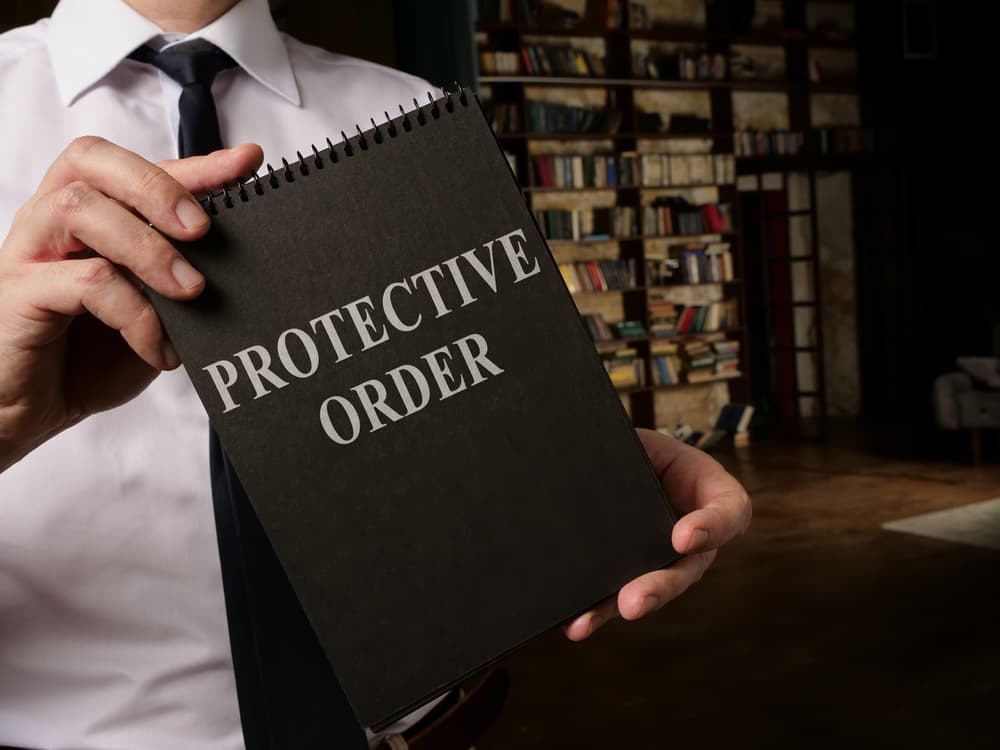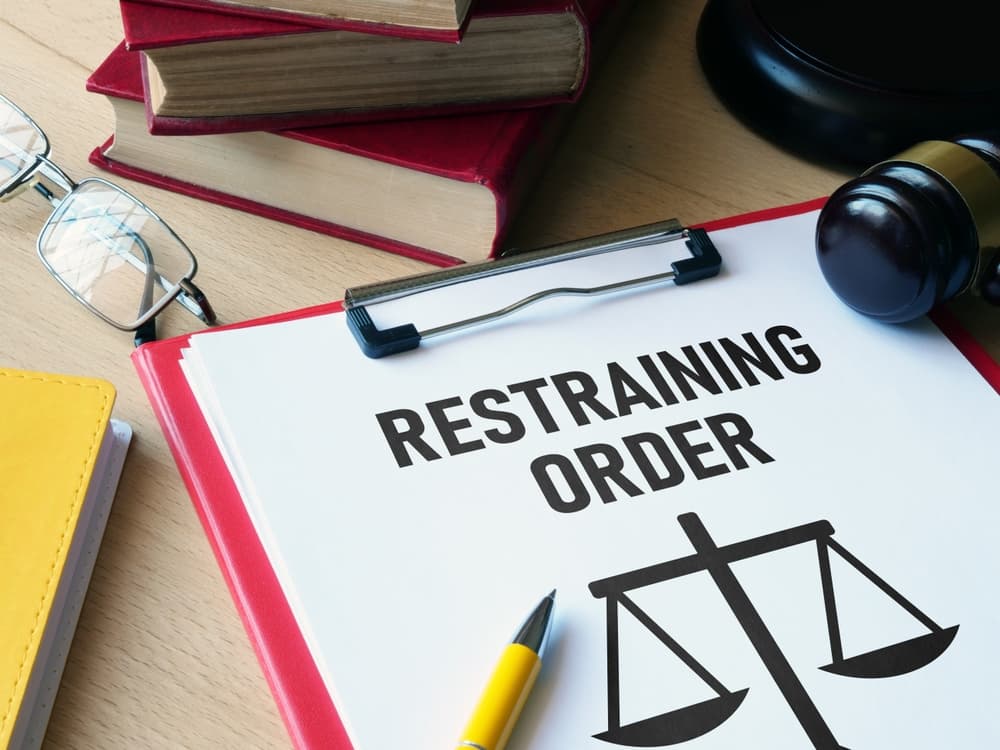Restraining orders can place severe limitations on individuals and their ability to contact family members, including children and other loved ones. In some situations, subjects of an order – with the help of a knowledgeable criminal defense lawyer – can petition the court to remove a restraining order. An experienced criminal defense attorney can meet with you right away to discuss your circumstances, review your options, and take the necessary legal steps on your behalf.
What is a Restraining Order, and When is One Issued?

A restraining order, also referred to as an order of protection (or protective order), is a legal directive issued by a court to prevent one person from contacting or approaching another person. It’s typically sought when people feel threatened or harassed and need legal intervention to ensure their safety. These orders are commonly issued in cases involving domestic violence, stalking, harassment, or threats of harm.
Several circumstances can lead to a restraining order being issued against someone, including all of the following:
- Domestic Violence – If there is evidence or a history of physical violence, threats, or intimidation within a domestic relationship (such as spouses, partners, or family members), a victim can petition the court for a restraining order. This aims to create a safe distance and prevent further abuse.
- Stalking – When someone engages in repeated unwanted behaviors such as following, monitoring, or harassing another person, the victim may seek a restraining order to stop the stalker from contacting them.
- Harassment – Persistent and unwanted actions that cause emotional distress or fear can also warrant a restraining order. This includes actions like incessant phone calls, text messages, or showing up uninvited at the victim’s home or workplace.
- Threats of Harm – Verbal or written threats of violence, regardless of whether they are carried out, can justify the issuance of a restraining order. The objective is to prevent potential harm by legally mandating distance and non-contact.
The process of obtaining a restraining order typically involves filing a petition with the court, where the petitioner (the person seeking protection) provides evidence and explains the reasons for their request. A judge then reviews the petition and decides whether to grant a temporary restraining order (TRO), which provides immediate protection until a full hearing can be held. At the hearing, both parties have the opportunity to present evidence and testimony before a final decision on the restraining order’s issuance is made.
If a restraining order is granted against someone, it imposes specific restrictions. These may include maintaining a certain distance from the petitioner, refraining from any form of contact (direct or indirect), and avoiding places that the petitioner frequents. Violating these terms can result in serious legal consequences, such as fines, imprisonment, or additional charges.
What are the Effects of a Restraining Order on Your Life?
A restraining order can have significant effects on various aspects of a person’s life, affecting both the person against whom the order is issued (the respondent) and the person whom the order protects (the petitioner). Here are several ways in which a restraining order can influence someone’s life:
- Legal Restrictions – The most immediate effect of a restraining order is the legal restrictions it imposes. These typically include orders to stay away from the petitioner, their home, workplace, or other specified locations. The respondent must refrain from any form of contact with the petitioner, whether in person, via phone calls, texts, emails, or through third parties.
- Effect on Personal Relationships – A restraining order can also strain or sever existing relationships. For instance, if the respondent and petitioner share mutual friends or social circles, these individuals may feel compelled to choose sides or distance themselves to comply with the order’s terms. Family dynamics can also be affected, particularly in cases where relatives are close to both parties.
- Employment Consequences – Depending on the nature of the allegations and the terms of the restraining order, it may affect employment. For instance, if the respondent and petitioner work together or in close proximity, the order may require adjustments to work arrangements. Additionally, employers may become aware of the restraining order through background checks or legal notifications, potentially affecting the respondent’s job prospects or current employment.
- Housing and Living Arrangements – In cases where the respondent and petitioner live in close proximity, the restraining order may require the respondent to find alternative housing. This can be disruptive and financially burdensome, particularly if immediate arrangements are necessary to comply with the order’s terms.
- Psychological and Emotional Effects – Being subject to a restraining order can have profound psychological effects. It may cause stress, anxiety, and feelings of isolation or stigma. The respondent may experience a range of emotions, including anger, frustration, and confusion about the legal process and the allegations made against them.
- Criminal Penalties for Violation – Violating a restraining order can lead to severe consequences, including fines, imprisonment, or additional charges. Law enforcement agencies take violations seriously and may actively monitor compliance with the order.
Seeking experienced legal counsel can provide clarity on rights, responsibilities, and options for modifying or contesting the order if deemed appropriate.
What Happens if You Violate a Restraining Order?
Violating a restraining order can lead to serious legal consequences that vary depending on the jurisdiction and specifics of the case. Here’s what typically happens if someone violates a restraining order:
- Legal Ramifications – Violating a restraining order is considered a criminal offense. The severity of the consequences can range from fines to imprisonment, depending on the circumstances and any previous violations. In some cases, the penalties may be more severe if the violation involves threats, physical harm, or repeated offenses.
- Arrest – Law enforcement agencies take violations of restraining orders seriously. If the petitioner or someone else reports a violation, the police can arrest the violator. This can happen even if the violation is unintentional or if the petitioner initiates contact.
- Court Appearance – After an arrest for violating a restraining order, the violator will likely have to appear in court. They will be formally charged and have the opportunity to defend themselves. The court will review the circumstances of the alleged violation and determine appropriate penalties.
- Penalties and Consequences – The penalties for violating a restraining order can include fines, community service, probation, or imprisonment. The specific penalties imposed depend upon factors like the seriousness of the alleged violation, any history of prior violations, and the judge’s discretion.
- Modification of Order – If the protected person wishes to modify or cancel the restraining order, they must go through the legal process to request changes. Simply ignoring the order or attempting to reconcile without legal modification does not nullify the restrictions.
- Future Legal Implications – A restraining order violation can have long-lasting consequences beyond immediate penalties. It can affect future court proceedings, such as custody hearings or divorce proceedings, and may appear in background checks for employment or housing opportunities.
It’s essential for anyone subject to these orders to comply fully and seek legal help if they have questions about their obligations or rights under the order.
What is the Process of Removing a Restraining Order?
The process of removing a restraining order, also known as lifting or modifying an order of protection, involves several steps that must be followed through legal channels. Here’s a detailed overview of how this process typically works:
- Evaluate the Need – Before seeking to remove a restraining order, it’s crucial to assess whether the circumstances that led to its issuance have changed sufficiently. Courts generally require a substantial reason to modify or lift the order, such as improved relationships, changes in living arrangements, or evidence that the original concerns no longer exist.
- File a Motion – To begin the process, the respondent must file a formal motion with the court that issued the order. This motion explains the reasons for requesting the modification or removal of the order. It’s important to provide clear and compelling evidence supporting the request, such as documentation of counseling sessions, improved behavior, or changed circumstances.
- Court Hearing – Once the motion is filed, a court hearing will be scheduled. Both parties (i.e. typically the respondent and the petitioner) will receive notice of the hearing date. It’s essential for the respondent to attend the hearing, where they can present their case directly to the presiding judge.
- Present Evidence – During the hearing, both parties have the opportunity to present evidence, testimony, and arguments to support their positions. The petitioner may also express their concerns regarding the requested modification. The judge will carefully consider all presented information before making a decision.
- Judicial Decision – After reviewing the evidence and hearing from both parties, the judge will decide whether to grant or deny the motion to modify or lift the restraining order. The judge’s decision is based on whether there is sufficient justification to alter the terms of the order in light of the current circumstances.
- Notification of Outcome – Following the hearing, the court will notify both parties of the judge’s decision. If the request to remove or modify the restraining order is granted, the terms of the order will be adjusted accordingly. It’s important to comply with any remaining conditions of the order until the court formally updates its terms.
- Follow-Up Actions – Depending on the jurisdiction, there may be additional steps or paperwork required to finalize the modification or removal of the restraining order. It’s advisable to consult with legal counsel throughout this process to ensure compliance with all legal requirements and to understand any potential implications of the court’s decision.
Removing a restraining order involves a formal legal process that requires adherence to procedural rules and the presentation of compelling evidence. It’s essential for people seeking to modify or lift a restraining order to approach the process diligently and to seek appropriate legal guidance to navigate the process effectively.
How Can a Lawyer Successfully Defend You at a Restraining Order Hearing?
A lawyer can provide crucial defense and support during a restraining order hearing, where the petitioner seeks protection from the respondent. Here’s how a lawyer can defend you:

- Legal Knowledge – A criminal defense attorney who regularly handles restraining order cases understands the complexities involved. They can navigate legal procedures, ensuring that all necessary documents are filed correctly and deadlines are followed.
- Evidence Gathering – Before the hearing, your lawyer will gather evidence to support your defense. This may include witness statements, communication records, or documentation proving misunderstandings or lack of intent in alleged incidents.
- Cross-Examination – During the hearing, your lawyer can cross-examine witnesses whom the petitioner presents. This allows them to challenge the credibility of statements made and bring out inconsistencies or gaps in the petitioner’s evidence.
- Presenting Your Case – Your lawyer will present your side of the story clearly and persuasively to the presiding judge. They will highlight relevant facts and evidence that support your defense, aiming to demonstrate that the restraining order is unnecessary or unjustified.
- Legal Arguments – Criminal defense lawyers are skilled in making legal arguments based on statutes, case law, and precedents. They will argue why the evidence and circumstances of your case do not warrant the continuation or issuance of a restraining order.
- Negotiation and Settlement – In some cases, your lawyer may negotiate with the petitioner’s lawyer outside of court. They can explore the possibility of reaching a settlement or agreement that addresses concerns without the need for a full hearing.
- Protecting Your Rights – Your lawyer can also ensure that your constitutional rights are upheld throughout the legal process. They will challenge any violations of due process and advocate for fair treatment under the law.
- Appeals and Post-Hearing Actions – If the hearing does not result in a favorable outcome, your lawyer can advise on the possibility of appealing the decision or taking other legal actions to protect your rights and interests.
Having a lawyer represent you at a restraining order hearing is essential for ensuring that your side of the story is effectively communicated and that your rights are vigorously defended. They provide knowledgeable, strategic guidance and advocacy to achieve the best possible outcome in a challenging and emotionally charged legal situation.
Contact an Experienced Restraining Order Lawyer Right Away About Your Legal Matter
Being the subject of a restraining order is extremely serious. A skilled criminal defense attorney in your area can evaluate your options, answer your questions, and pursue a restraining order removal or other favorable result on your behalf.

